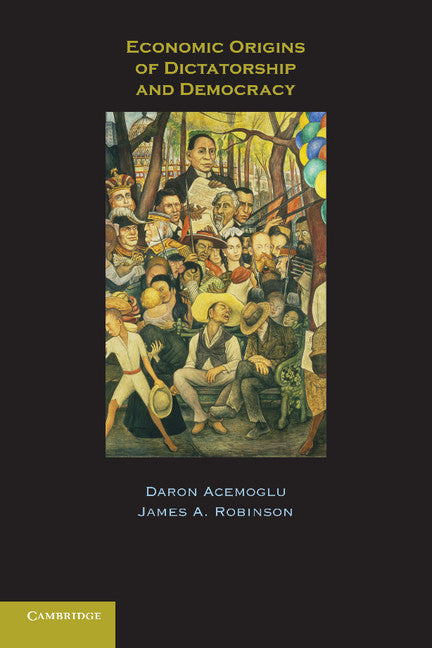Freshly Printed - allow 6 days lead
Couldn't load pickup availability
Economic Origins of Dictatorship and Democracy
This book systematically explains why some countries are democracies while others are not.
Daron Acemoglu (Author), James A. Robinson (Author)
9780521671422, Cambridge University Press
Paperback, published 9 February 2009
434 pages, 43 b/w illus.
23.1 x 15.5 x 2.5 cm, 0.61 kg
'The book is an ambitious attempt to offer tentative answers to some age-old questions in political economy and political science. … the book is well-written and structured as well as innovative and newsworthy, allowing Acemoglu & Robinson to win a general audience from political science. … the book can be useful for graduate studnets from economics with a focus on political economy.' CEU Political Science Journal
This book develops a framework for analyzing the creation and consolidation of democracy. Different social groups prefer different political institutions because of the way they allocate political power and resources. Thus democracy is preferred by the majority of citizens, but opposed by elites. Dictatorship nevertheless is not stable when citizens can threaten social disorder and revolution. In response, when the costs of repression are sufficiently high and promises of concessions are not credible, elites may be forced to create democracy. By democratizing, elites credibly transfer political power to the citizens, ensuring social stability. Democracy consolidates when elites do not have strong incentive to overthrow it. These processes depend on (1) the strength of civil society, (2) the structure of political institutions, (3) the nature of political and economic crises, (4) the level of economic inequality, (5) the structure of the economy, and (6) the form and extent of globalization.
Part I. Questions and Answers
Section 1. Paths of Political Development: 1. Britain
2. Argentina
3. Singapore
4. South Africa, 5. The agenda
Section 2. Our Argument: 1. Democracy vs. nondemocracy
2. Building blocks of our approach
3. Towards our basic story
4. Our theory of democratization
5. Democratic consolidation
6. Determinants of democracy
7. Political identities and the nature of conflict
8. Democracy in a picture
9. Overview of the book
Section 3. What Do We Know About Democracy?: 1. Measuring democracy
2. Patterns of democracy
3. Democracy, inequality and redistribution
4. Crises and democracy
5. Social unrest and democratization
6. The literature
7. Our contribution
Part II. Modelling Politics
Section 4. Democratic Politics: 1. Introduction
2. Aggregating individual preferences
3. Single-peaked preferences and the median voter theorem
4. Our workhorse models
5. Democracy and political equality
6. Conclusion
Section 5. Nondemocratic Politics: 1. Introduction
2. Power and constraints in nondemocratic politics
3. Modeling preferences and constraints in nondemocracies
4. Commitment problems
5. A simple game of promises
6. A dynamic model
7. Incentive compatible promises
8. Conclusion
Part III. The Creation and Consolidation of Democracy
Section 6. Democratization: 1. Introduction
2. The role of political institutions
3. Preferences over political institutions
4. Political power and institutions
5. A 'static' model of democratization
6. Democratization or repression?
7. A dynamic model of democratization
8. Subgame perfect equilibria
9. Alternative political identities
10. Targeted transfers
11. Power of the elite in democracy
12. Ideological preferences over regimes
13. Democratization in pictures
14. Equilibrium revolutions
15. Conclusion
Section 7. Coups and Consolidation: 1. Introduction
2. Incentives for coups
3. A static model of coups
4. A dynamic model of the creation and consolidation of democracy
5. Alternative political identities
6. Targeted transfers
7. Power in democracy and coups
8. Consolidation in a picture
9. Defensive coups
10. Conclusion
Part IV. Putting the Models to Work
Section 8. The Role of the Middle Class: 1. Introduction
2. The three-class model
3. Emergence of partial democracy
4. From partial to full democracy
5. Repression: the middle class as a buffer
6. Repression: soft-liners vs. hard-liners
7. The role of the middle class in consolidating democracy
8. Conclusion
Section 9. Economic Structure and Democracy: 1. Introduction
2. Economic structure and income distribution
3. Political conflict
4. Capital, land and the transition to democracy
5. Financial integration
6. Increased political integration
7. Alternative assumptions about the nature of international trade. 8. Conclusion
Part V. Conclusion and The Future of Democracy
Section 10. Conclusion and the Future of Democracy: 1. Paths of political development revisited
2. Extension and areas for future research
3. The future of democracy
Part VI. Appendix
Section 11. Appendix to Section 4: The Distribution of Power in Democracy: 1. Introduction
2. Probabilistic voting models
3. Lobbying
4. Partisan politics and political capture.
Subject Areas: Political economy [KCP], Economics [KC], Political structures: democracy [JPHV], Politics & government [JP]


